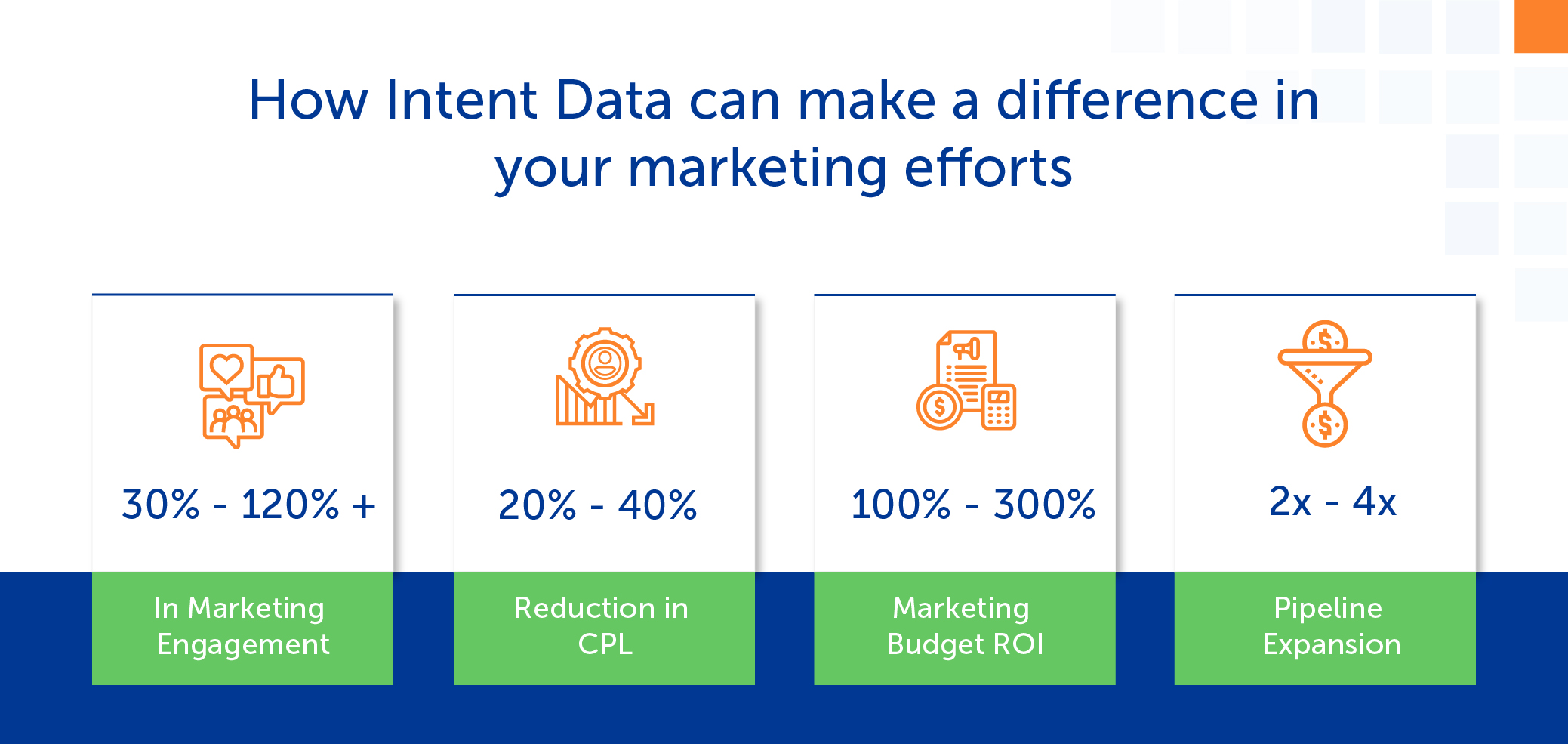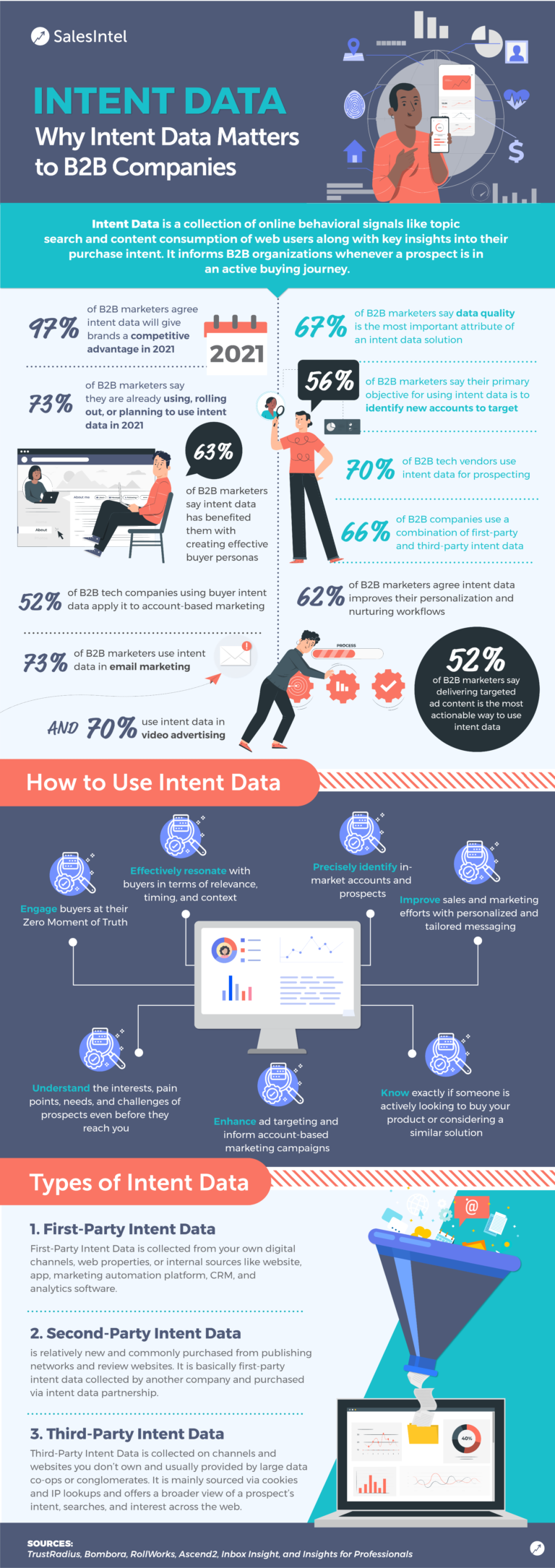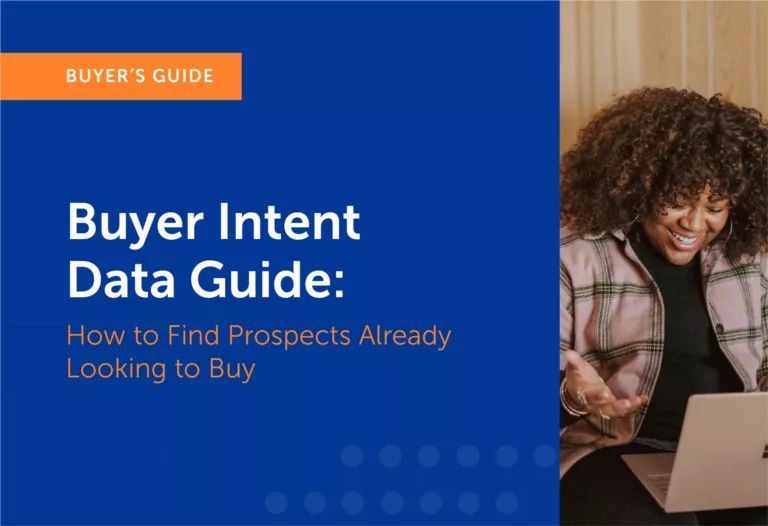B2B sales and marketing success depend heavily on data. However, it is not enough to use the data only for reaching your prospects. Every good marketer and sales professional knows the potential value of B2B Intent data and its power to help achieve comprehensive business objectives. A good understanding of the customer needs armed with data intelligence will not only give a competitive edge, but it will also help you build a strong and consistent pipeline for the sales team to take over.
However, only a few marketers and sales professionals know how to make smart use of the data to truly take advantage of the vast array of customer insights it offers. And one of the most important types of data for driving sales and marketing insights is Intent Data.
What is Intent Data?
In simple words, Intent Data is the set of behavioral signals that helps you to understand the intention of your prospects to purchase a product or service.
Your prospects are out there, looking for a solution to a problem you might fix. They search online, consume content, look for solutions, and learn ways to ease their pain.
According to studies, before engaging with a salesperson, an average B2B prospect is already 67% of the way into the purchasing journey. Combining prospect signals with buyer Intent Data provides a clearer bird’s eye view to help leverage customer insights to the company’s advantage. This means prospects have an intention to buy a product or service and a sales rep has to focus on the remaining 33% to close the deal.
Here is how intent data can make a difference in your marketing efforts:

What Makes Buyer Intent Data More Valuable Than Other Data?
Once prospective buyers hit your website, you can monitor their activity and assign them lead scores. You can use retargeting ads or email campaigns to nurture the leads when someone fills out and submits a form on your website.
Great! However, what about all those prospects that are looking for solutions like yours elsewhere on the web and not on your website? When your prospects go to other websites, you don’t have visibility into what they are engaging with. Only a fraction of buyers actively searching for a solution will make it to your site without sales and marketing outreach, and even of those hitting your site only about 15% of them will be actively engaged in a buying decision.
Here is when buyer Intent Data data helps you to identify those prospects who are actively engaged in a buying decision based on the type of content they are consuming.
Why Intent Data is the Future of B2B Marketing & Sales?
Understanding buyers’ intent is a must for any marketer or salesperson looking for a higher success rate and for those who are constantly searching for ways to get ahead. Understanding prospects’ behavior and triggers help businesses to understand what makes them buy and when. Marketing and sales teams can target a specific profile with this knowledge and take a personalized approach for them on demand to increase the likelihood of a purchase decision.
With numerous aggregated intent signals, businesses can identify “ready to buy” prospects and fine-tune their campaigns accordingly. Intent Data can be used for future prospecting as they reveal certain patterns, helping you to boost the purchase decisions of your prospects on their buyer journey.
Given that, it is important for you to know that if your competitor doesn’t already use the Intent Data, they might soon start using it. The report shows that 25% of B2B businesses are currently using intent data, while another 35% are preparing to use it within a year.
Check this detailed infographic –

How to Use Intent Data for Your Business?
Here we will break down how you can make the Intent Data work for you and your campaigns. To remain competitive, the use of buyer Intent Data is increasingly important. There are many areas where it can make a huge impact. Here are the key ways you can take advantage of Intent Data.
1. Identifying Early Opportunities
The most obvious use of intent data is tapping prospects earlier in the buying process. One of the best ways to get a leg up on the competition is to get in contact with prospects before other salespeople do. Research shows that in 70% of cases, companies prefer a salesperson offering the business who communicates with them first.
When you approach prospects through marketing campaigns, there is a good chance that one segment of the audience is not in the correct buying phase to connect with your content. You are too late to reach out, or you are reaching them at the same time as the rest of your rivals. This is why B2B marketers are beginning to recognize the value of employing Intent Data to improve the success of marketing initiatives. Learn more about how Intent Data works for marketers.
2. Lead Scoring
Buyer Intent Data can help to distinguish between who is actively researching a pain point and who is simply reading about a particular topic without any intention to make a purchase. This information highlights whether a lead fits your ideal customer profile or not and makes prioritization easy.
A lead scoring model requires time, brainstorming, and effort. As a result, it frequently takes a long while to set up, monitor, and enhance the process. This is where SalesIntel’s buyer intent data can come in handy.
SalesIntel assists you in identifying your prospects’ purchase signals based on intent subjects that have been thoroughly explored by organizations. With around 7,000 Intent themes regularly watched, you can learn what your potential buyers are interested in before you reach out to them.
Each account receives a live score based on the level of interest in a specific theme. The higher the rating, the more information the account has consumed relevant to the Intent topic you picked. The lead scoring methodology is simplified because it is an automated procedure. By filtering the themes relevant to the products and services, you can locate accounts with the highest conversion potential. Learn more about setting up a lead scoring model using Intent Data.
3. Account-Based Marketing
Account-based marketing is all about relationships. Intent Data can become the most important contributor to engaging and building relationships with the right prospects. While ABM often requires technographic and firmographic data, it is vital that you use every possible avenue to collect more information about your prospects that will help you take a laser-focused approach.
Intent Data not only helps you expand your reach, but it also gives you data that you might not be able to collect yourself. This data helps you to find more in-market customers, score leads with greater precision, and re-shape your ABM campaign with customized messaging.
Research shows about 10% of buyers are actively buying or want to buy at any given time. If you have a target list of 100 accounts, 10 of them represent immediate opportunities. The question is, which 10? This is where intent data comes into play.
You can reasonably forecast what a company wants to buy if you know what they are actively looking for. That is precisely what intent data provides. Thousands of subjects about various products and services are continually tracked to see which companies are interested in specific themes. The more a prospect examines a topic, the more likely they are to purchase in that category.
Learn more about how to use Buyer Intent Data for ABM success.
4. Refining Your Content Strategy
Intent Data helps you create a content strategy that matches what your ideal customers want to see. While several SEO tools can help you find the top keywords, and trending topics, incorporating Intent Data will give you a whole new layer of information to strengthen your content marketing strategy.
5. Targeted Advertising
Make your advertising campaigns even more granular by capitalizing on leads that exhibit certain signals using buyer Intent Data. That way, you don’t waste any of your advertising dollars on people who have only a passing interest and don’t intend to buy your product.
Once you are able to connect the dots between what your B2B buyers need and their buying signals, then you can start sharing specific content that will help them meet their objectives and opens-up an opportunity for you.
6. Fuel Your Sales Pipeline
Driving company results demands more than simply following an end-to-end plan. You must go beyond only identifying and engaging demand in your marketing funnel.
It is no longer enough to create innovative lead generation campaigns. It is necessary to research your target market, understand their behavior, and approach them with unique content. Personalizing your marketing plan has gone beyond demographic and firmographic data on your target audience.
In a world where sales must do more with less – time, money, and attention – intent data provides insight into where to concentrate effort and engage in activities. To maximize your sales pipeline, you should focus on intent data. Intent data is used by B2B marketers to create effective and personalized campaigns.
Watch this webinar by Intent Data leaders Bombora and SalesIntel where the experts have covered how to use Intent data in SalesIntel to fuel your sales intelligence and drive pipeline growth.
7. Send Effective Direct Emails
Intent data can and should influence all aspects of your prospect marketing, including direct mail.
You can utilize tactile marketing automation to apply that intelligence to direct mail and boost the impact and engagement of your brand. Integrated, branded, and personalized direct mail outperforms standard direct mail and is the most successful channel for engaging members of the C-Suite. Intent data opens up a world of possibilities for automating customized brand interactions, especially if you can utilize your integrations to evaluate whether the visitor meets your ideal customer profile (ICP).
Learn more about how you can use intent data to get the right timing, content, and messaging for your direct mail campaigns.
—
Once you can connect the dots between what your B2B buyers need and their buying signals, then you can start sharing specific content that will help them meet their objectives and opens-up an opportunity for you.
How is Intent Data Collected?
Because your competitors may be unaware of Intent Data, they may continue to use blind targeting and untargeted client acquisition techniques. B2B salespeople and marketers who use intention data correctly may acquire prospective buyers more quickly and move them down the funnel more efficiently than their competitors.
So, how can you collect intent data? Should you try a DIY approach? Tracking user behavior without their agreement is a violation of the new GDPR and CCPA legislation, and can result in significant fines. So should you look for a data partner?
Well, different companies have different approaches to gathering Intent Data – with some practices better than others.
There are three sources to collect Intent Data:
- Independent Websites or Portals
- Bidstream
- Publisher Co-Ops
1. Independent Websites or Portals
Independent websites or portals collect customer information and share it with other parties. Although they cannot collect vast amounts of data, they can more than handle their users’ opt-in and authorization to share their data.
2. Bidstream
Bidstream data is user behavior recorded by an ad pixel and distributed via ad exchanges. The purpose data supplier will post an ad on a public site hosting content. Then they use the ad to scrape the keywords and visitor information on that site without the website owner’s or visitor’s knowledge.
3. Publisher Co-Ops
Publisher Co-ops are groups of publishers and websites that pool their data for all participants to profit from a larger data set. On the first interaction, each publication or website also demands the consent of its visitors.
Want to dive into more details? Here’s a detailed article explaining each Intent Data collection type.
Read About – Similar to Zoominfo
How Does Intent Data Work
Once the data is collected, it is analyzed to understand a person’s intent. This is done by identifying patterns and trends in the data, such as specific keywords or topics that are frequently searched for or discussed. This information can then be used to create more targeted marketing campaigns, improve customer engagement and sales.
Intent data is typically used in B2B marketing, lead generation, account-based marketing, and other sales strategies. It’s worth mentioning that some companies provide intent data in real-time and others in a period of time, depending on their data collection methodologies and data providers.
What Are Intent Signals
Intent signals are indicators or cues that reveal a person’s intent or interest in a particular product or service, it can be observed through a person’s online behavior such as searches, website visits, and social media interactions. Examples of intent signals include search queries, website visits, social media interactions, email engagement and form submissions. Understanding intent signals can help businesses understand their audience better, create more targeted marketing campaigns, and improve customer engagement and sales.
What is Intent Marketing
Intent marketing is a strategy that uses data about a person’s intent to inform and guide marketing efforts. This data is collected through various online behaviors, such as searches, website visits, and social media interactions, and analyzed to identify patterns and trends that indicate a person’s intent or interest in a particular product or service. Businesses use this data to create more targeted and personalized marketing campaigns, improve customer engagement, and increase sales.
Start Incorporating Buyer Intent Data in Your Prospecting
Intent data can be incredibly valuable on its own, however, it works best when paired with other data points such as firmographic, technographic, and engagement metrics to create a holistic scoring model that also reflects qualifying criteria and engagement. If used in the right combination, Intent Data can be a powerful predictor of which accounts have the highest chances of buying your product or service.
With SalesIntel, you get access to accurate and comprehensive B2B data that includes firmographic and technographic information about your ideal customer profile (ICP) along with access to buyer Intent Data. SalesIntel’s Intent Data will help you uncover your prospects’ buying signals by identifying and learning the intent topics that are actively being researched by specific accounts.
SalesIntel has simplified intent data search in our B2B data portal so that you can quickly get the actionable data you need to boost lead generation. Want to learn how to search for data that can help you take quick decisions and bring more value to your business?








